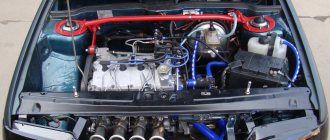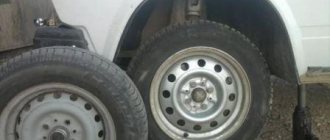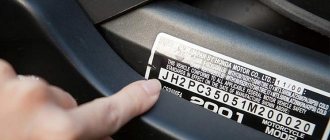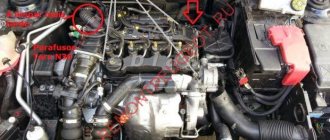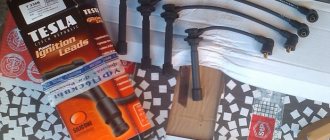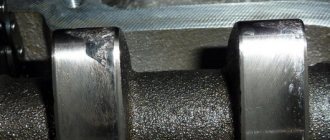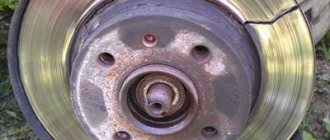Specifications and description
The VAZ 2115 has technical characteristics that are quite typical for the 2113-2115 family of models. Thus, the well-known engines of the 2111 and 1118 series were installed on the car. Let’s consider the main characteristics and design of the power unit:
VAZ 2111
| Name | Options |
| Volume | 1.5 liter (1499 cm3) |
| Number of cylinders | 4 |
| Number of valves | 8 |
| Fuel | Petrol |
| Injection system | Injector |
| Power | 77 hp |
| Fuel consumption | 8.2 l/100 km |
| Cylinder diameter | 82 mm |
VAZ 21114
| Name | Options |
| Volume | 1.6 liter (1596 cc) |
| Number of cylinders | 4 |
| Number of valves | 8 |
| Fuel | Petrol |
| Injection system | Injector |
| Engine power | 81.6 hp |
| Fuel consumption | 7.6 l/100 km |
| Cylinder diameter | 82 mm |
VAZ 11183
| Name | Options |
| Brand | 11183 |
| Marking | 1.6 8V |
| Type | Injector |
| Fuel | Petrol |
| Valve mechanism | 8 valve |
| Number of cylinders | 4 |
| Fuel consumption | 9.6 liters |
| Piston diameter | 82 mm |
| Resource | 200 - 250 thousand km |
Like the 2114, the 15th model had engines similar in characteristics and design. Of course, the VAZ 2115 engine did not receive the injector 16-valve power unit that car enthusiasts so wanted. Nevertheless, the car still managed to gain popularity and become popular not only in Russia, but also in the CIS countries.
Changes to the car compared to its predecessor
In the updated model, not only the external part of the car has radically changed, but the interior has also been significantly updated.
External differences from its predecessor:
- Bumper . The bumper became higher and was painted in body color, like foreign cars; before it, the 10, 11 and 12 models could boast of this.
- Headlights . The headlights became smaller and more rounded, and the optics themselves were quite modern at that time.
- Rear spoiler . Some trim levels were equipped from the factory with a small spoiler that did not differ in color from the car.
- Radiator trim and hood . The hood also differed favorably from its angular predecessor with its rounded shape, which made the 2114's design quite fresh.
- Wings . Slots for turn signals appeared in the wings and, in general, they began to integrate more advantageously into the overall appearance of the car.
- Side skirt fairings . The sills began to be covered with plastic covers and painted the same color as the body.
- Moldings . The moldings go along the doors and are in turn painted to match the color of the car's body.
Main characteristics (body)
| Number of seats | 5 |
| Minimum trunk volume (l) | 445 |
| Front wheel track (mm) | 1400 |
| Wheelbase (mm) | 2460 |
| Height (mm) | 1402 |
| Width (mm) | 1650 |
| Rear wheel track (mm) | 1370 |
| Permissible gross weight (kg) | 1425 |
| Curb weight (kg) | 1000 |
| Length (mm) | 4330 |
Should high-voltage wires be replaced and when?
No matter how well the armored wires are made, they also have a limited service life. According to current regulations, they must be replaced after every 30,000 km traveled. In practice, many motorists ignore this rule, continuing to travel with wires that have already outlived their useful life.
Such inattention can cause a whole host of problems, including:
- poor ignition;
- overclocking problems;
- engine tripping;
- inability to start the car.
All these troubles are caused by one single factor - an increase in the electrical resistance of the core of high-voltage wires, as a result of which it becomes “more difficult” for the impulse from the coil to reach its destination.
You can check whether you can still drive with the old wires or not - at home.
To do this you need:
- Turn off the ignition.
- Remove one of the armored wires.
- Measure its resistance using a megohmmeter or multimeter in the appropriate mode.
- If the resistance turns out to be equal to or close to the figure indicated on the wire insulation, then it is in good condition, but if it turns out to be greater, then the wire should be replaced.
- Repeat this operation on the remaining three wires.
It should be remembered that if only one of the wires is faulty, then all four should still be replaced.
Also, do not forget about the cleanliness of the contacts of high-voltage wires - they can also cause ignition problems. If oxides are noticeable on the metal tip, they should be cleaned with fine sandpaper or a cloth moistened with kerosene. By following these simple rules for caring for armored wires and replacing them, you can almost completely avoid troubles associated with the ignition system.
Engine
| Cylinder diameter (mm) | 82 |
| Number of valves per cylinder | 2 |
| Number of cylinders | 4 |
| Piston stroke (mm) | 75 |
| Maximum torque (N•m) | 120 |
| Maximum torque speed, max. (rpm) | 2700 |
| Maximum power speed, max. (rpm) | 5200 |
| Intake type | Injector |
| Engine Configuration | Row |
| Engine power (hp) | 81 |
| Engine capacity (cm3) | 1596 |
| engine's type | Petrol |
Specifications
| Type | Volume | Power | Torque | Overclocking | Maximum speed | Number of cylinders |
| Petrol | 1.5 l | 68 hp | 103 H*m | 13 sec. | 155 km/h | 4 |
| Petrol | 1.5 l | 78 hp | 115 H*m | 13.2 sec. | 158 km/h | 4 |
| Petrol | 1.6 l | 81 hp | 120 H*m | 13.2 sec. | 160 km/h | 4 |
More details
The model had weak units with a volume of 1.5 and 1.6 liters in its line; you can see their characteristics above. They were paired only with a 5-speed manual transmission. Nevertheless, for some time there was a package that equipped the model with a 1.3-liter rotary carburetor unit producing 135 horsepower, allowing the model to reach a hundred in 9 seconds.
The 1.5-liter unit produces 68 horsepower, not much, but enough to accelerate the model to hundreds in 13 seconds. The maximum speed will be 158 km/h. Consumption is around 9 liters in the city and it is advisable to fill in 95 gasoline.
What does the price depend on?
Motorists who need engine overhaul of a VAZ-2114 are faced with different prices for such a service. The cost depends on the influence of factors:
- Engine capacity.
- The prestige of the service company, its pricing policy.
- Urgency.
- Scope of work.
- Difficulty of repair.
- The need for a specialist to visit.
- Cost of spare parts.
- Equipment used.
- Automotive technician qualification level.
The more work is required to restore the engine of a VAZ-2114 car, the more expensive the service of a specialist will cost. You will have to pay extra for urgency and a specialist visit.
Service and Frequently Asked Questions
The design of the 2115 engine allows the car enthusiast to carry out vehicle maintenance with his own hands. The service interval is 13-15 thousand kilometers. For those who want to preserve the engine longer and extend its service life, it is recommended to reduce the period of scheduled maintenance to 10,000 km.
In addition to the scheduled oil change, other diagnostic work should be carried out on the VAZ 2115 engine at each service center. For example, it is necessary to visually inspect the engine for leaks, check the condition of the timing belt and diagnose the performance of all systems and sensors. It is worth remembering that good maintenance extends the life of the engine.
FAQ
After looking through the forums and talking with auto mechanics, we can come to the conclusion that owners of the VAZ 2115 engine with 8-valve injector ask the same questions every time. Let's try to take into account the data obtained, and then group the questions and give answers to them.
- Do valves bend in a VAZ 2115? — As with any other vehicle, of course it’s oppressive. This happens when the timing belt breaks. To prevent this from happening, it must be changed every 45-50 thousand kilometers or if failure is suspected. It is worth noting that it will not only bend the valves, but also damage related elements, and may also leave a mark on the pistons. In any case, this will lead to a major overhaul of the power unit.
- Where is the engine number on the VAZ 2115? — As in all Lada models, you can find the engine number on the gearbox side, near the thermostat. The engine number always has a pad on the cylinder block, which is located in a visible place.
- What is the oil volume in the 2115 engine? — The engine oil volume is 3.5 liters. But, with this question, car enthusiasts ask another one - What oil is best to fill in the 2115 engine? — The most recommended motor oil for the engine is considered to be 10W-40. Also, auto mechanics recommend using 5W-30 and 5W-40. In this case, the oil manufacturer remains at the discretion of the vehicle owner.
From what year and why was production of the VAZ 2115 discontinued?
In 2012, the Lada Granta was released. With a more attractive design and better technical characteristics, its cost was comparable to the cost of the VAZ 2115. This is one of the reasons why the production of the popular 2115 model was discontinued.
In addition, a stream of foreign cars, new and used, has poured into the Russian market.
The opinions of potential buyers both in Russia and in the countries where the VAZ 2115 was exported were divided. Given the same cost of cars, many motorists preferred to opt for more comfortable, equipped and reliable foreign cars with a short service life. Others believed that a new one is a new one, and at least during the warranty period there would be no problems with the 2115 car. And domestically produced spare parts are cheaper.
Demand for the popular model began to fall, and its monthly sales volume dropped to 500 cars per month.
To increase demand for the VAZ 2115, the Volzhsky plant took a number of measures. One of them is a significant discount on this model. The measure was a temporary success. Demand for the VAZ 2115 has increased by more than 70%. But this was a successful last attempt. In 2011, sales decreased by 44%, and the plant management decided to stop producing this model on January 1, 2012. But production continued until the end of the year.
- Which is better: VAZ 2110 or VAZ 2115 according to experts
On December 27, 2012, the last production VAZ 2115 rolled off the assembly line in Tolyatti.
Over the years, more than 10 million cars of this model have been produced.
But the production of Lada Samara cars did not end there. Until the end of 2013, production of its modifications 2113 and 2114 continued in Tolyatti.
Subsidiaries of the Volzhsky Automobile Plant, which produced cars based on the VAZ 2115, switched to producing cars based on the Lada Granta.
It is impossible to answer exactly from what year the sale of “Fifteen” completely ceased. Cars remained in dealers' warehouses and were sold for a long time.
When there is not enough money to buy an expensive car, used domestic cars can be a good option. Also, many people prefer to choose them when they need to hone their driving skills. And some don’t even want to buy foreign cars on principle. One of these options is VAZ-2115 . Before purchasing, you should carefully study not only the positive aspects, but also all sorts of disadvantages, so that there are no misunderstandings later.
Interior
The interior decoration is simple, with regular chairs with fabric upholstery. In the back there is a sofa for three passengers. There is not much space, but in principle it is enough. There is a simple stove, which is very easy to operate, since everyone is familiar with this unit.
The steering column is familiar to many - a simple 3-spoke steering wheel. The instrument panel is also made in the classic style for AvtoVAZ, these are ordinary analog gauges and a small and uninformative on-board computer.
The trunk of the car, of course, is not particularly large, but for ordinary purposes it is enough. The luggage compartment volume is 445 liters.
In principle, the VAZ 2115 is an acceptable car for its price; of course, it has disadvantages and problems, but the price tells you about it.
AvtoVAZ in the 2000s and later
Since the 2000s, sales of VAZ cars have been sharply declining due to the opening of foreign concerns that offered consumers more reliable and modern cars at relatively affordable prices. The management team again decides to update the model range. All subsequent cars did not gain popularity among potential consumers. The only exception is the VAZ-2114, which is still considered by many to be almost the best vehicle in the entire history of AvtoVAZ.
Electrical equipment VAZ 2115
Electrical equipment has also been improved. Now the car's package includes: electric windows for the front doors, as well as fog lights and heated seats (only on “luxury” modifications). All versions are equipped with an on-board monitoring system that allows you to monitor the proper operation of lamps, oil level, brake pad wear, and the level of coolant and washer fluids, directly from the driver’s seat. At high speeds (namely 180-200 km/h) the road holds up well. The cross-country ability is very good for its class, the car is light and tall. Spare parts and repairs are relatively inexpensive. The trunk is very large, which is good.
car front panel
Design
For quite a long time, the interior of cars under the Lada brand did not stand out in any way. But many people liked the appearance. In 2008, a decision was made to make a small change, as modern fashion for the appearance of a car had changed. The designers decided to change the moldings on the doors. If before 2008 they were wide and painted in a standard color on all cars, then after they were narrowed and the color scheme was changed.
Many say that these decisions have improved the appearance of the car, while some argue, on the contrary, that it has only made things worse. There were opinions that the car no longer stood out in the urban crowd.
Repair of injectors VAZ 2114/2115
Repairing injectors involves carrying out a number of works at once:
- cleaning;
- purging;
- replacement of rubber seals.
After the products have been removed from the fuel rail, you need to take a good look at each of the four nozzles. If there are visible signs of leakage on the body, repair will not be practical. You will have to immediately replace the nozzle with a new one. The differences in flushing and cleaning procedures for 8-valve and 16-valve engines are not significant. Therefore, you can be guided by the same scheme.
Video: the easiest way
If the body is clean and there are no deformations or cracks on it, then repair work is allowed . To do this, you will need to remove the seal from the body and the sprayer. It is recommended to leave these parts in acetone or solvent for 1.5–2 hours. While the parts are being washed, you can use a vacuum cleaner to clean the fuel rail. Next, you need to carefully clean the place where the injectors fit into the ramp using a toothpick or a needle.
After this, you can start purging the nozzle from the inside. You will need a roll of electrical tape, an aerosol can for cleaning carburetors and a syringe. An aerosol cleaning liquid is supplied through a thin syringe into the nozzle cavity. It is better to wrap the joint between the syringe and the tube of the canister for sealing with electrical tape. It is recommended to repeat washing the nozzle from the inside three times. Afterwards the product must dry. As soon as the body itself, as well as the seal and sprayer dry after washing, you can assemble the nozzle and install it on the ramp.
A cheap product will perfectly remove dirt and deposits from the nozzle
Before installation, each nozzle is tested for resistance . The tester readings should be in the range of 11–15 ohms.
There is also a simple way to clean the injectors, without dismantling the fuel rail. However, it is only appropriate in cases where the injectors have not yet exhausted their entire service life (120–150 thousand kilometers). The use of cleaning additives in gasoline is allowed. In this case, all elements of the fuel system will be cleaned, but its closed nature does not allow removing dirt and sediment from low-quality gasoline.
A broken fuel pump can cause serious problems. You can read more about this here:
The liquid is poured into the gas tank and, together with fuel, cleans all elements of the system
Work to improve technical equipment
In further production, when mass production of this car began, the engine was replaced with a more powerful one (VAZ-2111), its thrust was 77.8 liters. With. For the “fifteenth” this was not the last modification, because if you look under the hood of a car produced after 2007, you can find a VAZ-11183 engine. Power was increased to 80.9 hp. s in the updated VAZ-2115. Injector – 8 valves, front-wheel drive, 1.5 liter petrol power unit.
Many drivers noted that the car has a fairly high suspension for such sedans, as the car handles various bumps well and copes well with dirt roads. If we talk about numbers, the ground clearance of this car is 160 mm.
Malfunctions
| FAULTS | CAUSES AND REMEDIES |
| The engine does not start or runs with detonation and strong vibrations. | Injection system failure. It is necessary to open the engine, clean the injectors and check their functionality. |
| The engine is shaking, the idle speed is floating. | The throttle sensor or idle speed control has failed. Repairs are made only after a thorough diagnosis and consist of replacing the failed element. |
| The engine takes a long time to warm up or does not reach operating temperature at all. | The thermostat failed, which closed the circulation of liquid along a large circuit. The repair consists of replacing the thermostat. |
| The appearance of an extraneous knocking sound in the engine under load. | Valves are knocking and require adjustment. Repair in this case involves opening the engine and adjusting the valve clearance. |
Engine modification and tuning
Tuning the VAZ 2115 engine is divided into two substages - mechanical modification and chip tuning. The first option involves boring the cylinder block and installing an engine kit. But, as practice shows, mechanical tuning of the VAZ 2115 ends with superficial modifications to the engine.
For example, by installing silicone pipes, as well as a “zero” resistance filter. Although there are motorists who go all the way and do a complete mechanical tuning of the engine.
Chip tuning of the VAZ 2115 is carried out according to the scheme. The car enthusiast chooses one of the options: increasing power, reducing consumption or balanced, and after that the auto electrician programs the electronic engine control unit to the desired result.
The development of modern technologies makes it possible to carry out such an operation independently, without trips to a car service center. It is worth remembering that one awkward movement can lead to the engine working incorrectly or not starting at all.
Release history
The assembly of the Lada Samara model began back in 1997 at the Volzhsky Automobile Plant. Having its origins in Togliatti, the car almost immediately began to actively sell out throughout Russia. The production of this car did not end even during the 2008 crisis, when AvtoVAZ found itself in a difficult situation due to debts.
VAZ-2115 was a follower of VAZ-21099, many still call them relatives. But in 2004, AvtoVAZ considered that it was time for the “ninety-ninth” to rest, and stopped producing it, completely replacing production with a more advanced model - the “fifteenth”. Of course, car enthusiasts did not abandon the VAZ-21099, and this car is still on sale.
Production of the VAZ-2115 model, better known as “Samara”, ended only in 2012. It was replaced by cars that were much more modern and safer. One of the followers of the “fifteenth” is the Lada Granta car, which also belongs to the budget segment, but more modernized.
Performance characteristics of the VAZ 2115 car
The exhaust emission level of this model strictly meets domestic requirements and European environmental standards EURO-3 (Euro III), and the car’s reliable power units will never let its owner down on the road.
The VAZ-2115 is equipped with a five-speed gearbox combined with a differential and final drive.
The five-speed gearbox is designed on the basis of the four-speed gearbox previously installed on cars of the Sputnik family.
The main difference between the five-speed gearbox is the additionally introduced fifth gear, the gears of which are installed in an enlarged rear cover.
PS While driving, the gearbox does not cause any difficulties, the gears are engaged smoothly (except for fifth), without jerking the car, but at high speeds (over 120 km/h) when switching from fourth to fifth gear, difficulties arise, this can lead to a shift in attention from the road on the lever and there is a danger of losing control (trust my experience)
The main power supply circuits of the electrical equipment of the VAZ 2115 car are protected from damage by fuses. Their price is small, but their help and impact are significant. After all, they protect more expensive equipment.
The exceptions are:
- battery charging circuit;
- ignition circuit;
- starter and generator power supply circuit.
Protection is realized using a fuse box assembled in the engine compartment. All powerful consumers, such as the starter, wipers and high beam lamps, are connected to the on-board network via a relay and are located in the mounting block.
The Pyatnashka is equipped with a starter type 5712.3708 - this is a DC electric motor with excitation from permanent magnets, with a planetary gearbox and an electromagnetic two-winding traction relay.
Four permanent magnets are fixed in the stator housing. The armature shaft rotates in two metal-ceramic liners installed in the cover and support. Rotation from the armature shaft is transmitted to the drive shaft through a planetary gearbox. Planetary gears rotate on needle bearings. The front end of the drive shaft rotates in a sintered bushing pressed into the clutch housing.
When the starter is turned on, the voltage from the battery through the ignition switch is supplied to both windings of the starter traction relay (retractor P1 and retainer P2). After closing the contacts of the traction relay, the retractor winding is turned off.
The Fifteenth model also has engines with a distributed fuel injection system, i.e. fuel is injected by four injectors (one injector per cylinder) into the intake pipe, onto the intake valves. Here the fuel evaporates, mixes with air and enters the engine cylinders in the form of a combustible mixture. The fuel injection system reduces exhaust emissions while improving the vehicle's driving characteristics.
The history of the VAZ 2115
The first prototype of the VAZ 2115 from the Lada Samara family, popularly called “Pyatnashka”, was demonstrated in 1997 at the Moscow Motor Show. From the same year, its serial production was launched. The “Fifteen” differed favorably from its predecessor VAZ 21099 from the Lada “Sputnik” family (year of manufacture 1990) in the design of its front end; the fenders, hood and trunk lid received a more rounded shape. The metal bumper was replaced with a plastic one. The look has become more modern thanks to the side decorative overlays. The trunk, the opening of which began from the bumper, became more convenient. The length of the body increased by 22.5 cm. The car became streamlined and successfully passed tests in the wind tunnel.
- Main technical characteristics of the VAZ 2115 car
However, in 1999, designers significantly changed the appearance of the car. New front and rear optics were installed, an additional brake light appeared on the trunk spoiler, and the electrical equipment was improved. The interior has changed for the better.
Since 2007, the car began to be equipped with a 1.6 liter engine. After this improvement, the sedan began to meet European standards.
Compared to its predecessors, this model turned out to be the most expensive, but also the most prestigious. Sales volume amounted to 30% of all VAZ models. On average, 2,600 “Fifteen” cars rolled off the production line every month.
The demand and popularity of the new sedan grew. Therefore, since 2000, its assembly was transferred to the main conveyor belt of the Volzhsky Automobile Plant.
Tires, wheels
| Discs | Front | Rear |
| Rim width | 5 | 5 |
| Rim diameter | 13 | 13 |
| Number of mounting holes | 4 | 4 |
| Tires | Front | Rear |
| Tire diameter | 13 | 13 |
| Tire profile height | 70 | 70 |
| Tire section width | 175 | 175 |

